

... Marilyn Churchill
By Scott Stilphen

In 1980, Marilyn became one of the very first computer artists, pioneering the animation department at Atari games, as well as creating and art directing titles for many well-known clients which included Walt Disney, CTW Muppets, D.C. Comics, and Steven Spielberg. Later, she specialized in children’s educational software, creating titles in partnership with Fisher-Price Toys, McGraw-Hill, The Learning Company and others. These days, Marilyn is an award-winning artist and writer, and the creator of Mystic Heroine Adventures™ - a company devoted to entertaining girls and women with books and products that inspire them to live the creative, self-empowered life of their dreams. This is the first time she's spoken at length about her experiences at Atari, for which everyone here at Digital Press is grateful for.
DP: What artist(s) motivated you to pursue a career in art?
Marilyn Churchill: My first art influences were Walt Disney movies, Max Fleischer’s Betty Boop cartoons, and the wide range of children’s illustrations that I found in library books. As a child, I loved to escape into these fantasy worlds. And as far back as I can remember, I was excited by the magic of drawing a line.
DP: Did you work for anyone prior to Atari (after school)?
Marilyn Churchill: After graduating with a BA in Fine Arts from Wheaton College, I worked as an illustrator for Pioneer Girls, a publisher of children’s books and magazines.
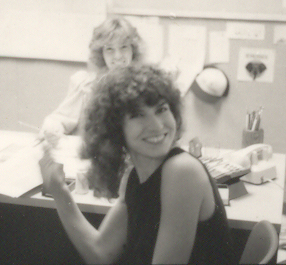 DP:
You were the first
graphics artist hired at Atari, in 1980. How did the opportunity at Atari come
about? Do you recall anything about your interview?
DP:
You were the first
graphics artist hired at Atari, in 1980. How did the opportunity at Atari come
about? Do you recall anything about your interview?
Marilyn Churchill: At that time I was married to Dave Theurer, who was a superstar in the Atari coin-op division. I had watched Dave create titles like Missile Command and Tempest, amongst others. I was already immersed in the game culture and it seemed logical for me to apply for a job at Atari. I interviewed for a position as a package illustrator with department head, John Hayashi, and Jim Kelly, from the art department. There was one line on my resume that stated that I had recently studied animation at DeAnza College. Jim was receiving requests from programmers in the consumer division to come up with crude little 8 x 8 pixel animations of running football figures, explosions and such. And he knew that there would be more and more requests as Atari expanded. They asked me if I would consider doing computer animation for the consumer division. I remember saying that that was what I’d really like to do. Especially since I would have freedom to pioneer this department for Atari.
(Right: Marilyn at Atari circa 1983. Photo courtesy of Alan Murphy)
DP: From my understanding, you were involved with basically setting up the graphics artist department, as far as hiring fellow artists such as Alan Murphy and Jerome Domurat, correct?
Marilyn Churchill: Yes. At first I created graphics for all the games under development—whatever the programmers didn’t want to do themselves. Within 6 months, there was more work than I could handle and I was told to start hiring. Alan Murphy was the first artist I hired. At that time, none of the artists had any computer graphics in their portfolio. But Alan was a proficient illustrator with a developed cartoon style and an edgy sense of humor—really an amazing artist. Obviously, he was perfect for the job. Jerome was the second artist I hired. He was logical, organized and had an intellectual approach to things that was wonderful. Mimi Doggett came next. She had such a good nature, was skilled at everything and filled in the gaps. That was my original team. This art department worked really well with our diverse, eccentric group of programmers, and we had a whole lot of fun.
DP: You worked on several different platforms (VCS/2600, 400/800, 5200). What was the development process like? And was your schedule fixed (i.e. 9 to 5) or could you basically come and go as you pleased?
Marilyn Churchill: Typically, game ideas were suggested at brainstorming sessions, which were crazy, weird events—often taking place at an offsite location over a couple of intense days of work and play. After game titles were decided on and programmers were selected, I would assign each game to an artist. Then it was my job to oversee the graphics and the schedule and offer advice or resources as needed. I would also have at least one game that I was personally working on. I reviewed all the completed games and signed off on them.
I ran a democratic department. I made sure that the artists had a voice. One of the things I’m most proud of is securing game royalties for the Atari artists.
The other artists generally kept regular hours. Alan would occasionally take off in the middle of the day to go surfing. I came in around 10 and worked late. Lots of programmers worked nights. During crunch time, with deadlines looming, the place resembled a college dorm during finals week.
DP: Was there one system that you enjoyed for more than others?
Marilyn Churchill: Of course, I enjoyed having more pixels and colors to work with on the later machines—but I enjoyed everything in its time. I was always trying to find cool solutions and special effects within the severe artistic limitations. But I will never forget the frustration of enduring the long processing time on the Atari 800’s that ran our animation program. I would often think, as I sat waiting, that I should take up knitting.
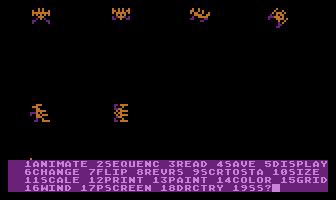 DP:
What sort of
animation tools did you have?
DP:
What sort of
animation tools did you have?
Marilyn Churchill: I started designing graphics at Atari on graph paper, marking off 8 x 8 boxes and coloring them in with colored pencils. Then I waited to see how they looked onscreen when the programmer entered it into their code. That was about as crude as playing the piano with your toes. Dave Theurer fixed that for me. He created an animation program that allowed me to use a joystick and menu options to design and view the animations onscreen. And he continued to develop and expand the software as new projects required new options. Other animation tools were eventually presented to our department, but during my time at Atari, Dave’s animation tool was the only one I used. Later, Dave went on to create DeBabelizer, a graphics conversion program that was invaluable to artists for many more years.
DP: Do you recall what the name of Dave’s Atari 800 animation program was? Jerome Domurat mentioned it was called “GGE” but he didn’t remember what the acronym stood for. I found a copy of it on floppy disc and it was simply named “Animat”.
Marilyn Churchill: GGE? Could be. Kind of rings a bell. Game Graphics Emulator? I'm guessing now. I don't remember calling Dave's program anything other than "Dave's program."
DP: Did your work mainly involve in-game graphics, or were you also involved with packaging or other items aside from video games?
Marilyn Churchill: I worked with onscreen graphics only, along with all my management duties, of course. I traveled quite a bit to consumer electronic shows and on diplomatic trips to meet with companies that we were partnering with; for example: Children’s Television Workshop (a division of The Muppets), Disney, and DC Comics. These trips were really fun and educational and have had a lasting influence on me.
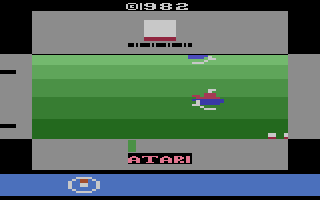 DP:
I know of at least
3 game titles that you (personally) worked on: Submarine Commander (VCS/2600),
Space Invaders (5200), and Meebzork (5200).
Can you
talk a bit about these, and any others you worked on?
DP:
I know of at least
3 game titles that you (personally) worked on: Submarine Commander (VCS/2600),
Space Invaders (5200), and Meebzork (5200).
Can you
talk a bit about these, and any others you worked on?
Marilyn Churchill: Matt Hubbard's Submarine Commander was one of the first projects I worked on and I remember initially feeling very frustrated by all the artistic and design limitations. I remember Matt as a refined intellectual. He liked opera and would often quote long passages from the movie, Casablanca, which was always amusing. Once, at a department meeting, I remember him handing back a royalty check for tens of thousands of dollars on some moral grounds that were never quite clear to me. I often wonder what happened to that check.
DP: I can help solve part of the mystery. Back in 2001 I had the opportunity to interview Matt and he talked about giving back a $30,000 check to Atari, and why he did it.
Marilyn Churchill: Thank you for clarifying that!
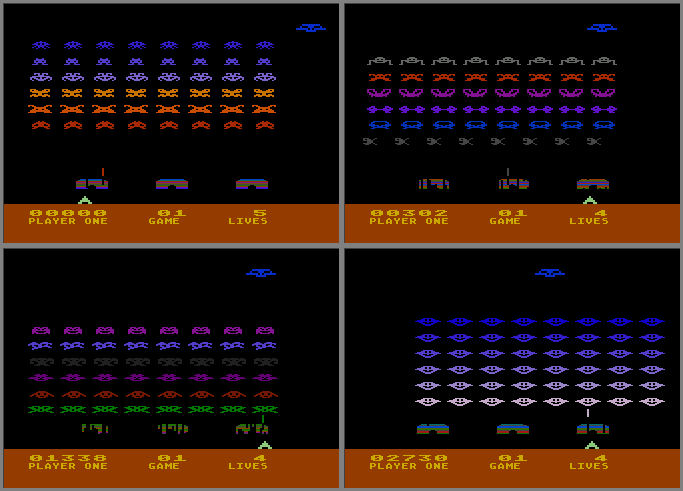
There are 2
waves of one set of invaders (upper-left), 2 more of another set (upper-right),
2 more of yet another set (lower-left),
and then 1 wave of invaders that all
morph into 3 different types (lower-right).
Marilyn Churchill: I had a really good time working on Space Invaders with Eric Manghise, who was the programmer. He was very artistic himself and we tried to really finesse some new graphics for this classic game. I was experimenting with a new animation technique that I called “Matrix Animation.” I would design a looping animation sequence and place it horizontally on a grid. Below that I created a similar but distinctly different looping animation that was cross-animated with the level above. Then I added more levels below that; each with unique and cross-animated action. Eric’s program ran the animation sequence with a randomly generated option to skip one level up or down at every step in the sequence. The result simulated real, unpredictable behavior. It was challenging to design and pretty cool at the time.
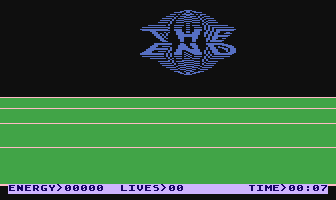
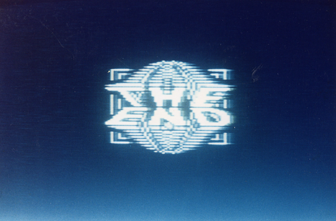
DP: I noticed in your Matrix animation notes (below) that you refer to the creatures as Gargoyles. A draft version of the manual was found that refers to them as "Gorgons". I also noticed that one of your photos of Meebzork show the 'game over' screen with a different "THE END" graphic that doesn't exist in the 2 prototype versions that have been found to date.
Marilyn Churchill: Eric came up with the good idea to call my gargoyles "Gorgons". I like "The End" better with the frame around it. Eric and I tried to take Matrix Animation a lot further in Meebzork, but unfortunately, Meebzork was never completed or released.
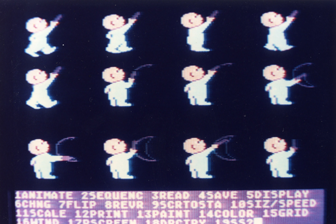 DP:
Were there any other games or projects you worked on at Atari?
DP:
Were there any other games or projects you worked on at Atari?
Marilyn Churchill: At one time I was asked to create a "Harold and His Purple Crayon" demo for Harper and Row. Unfortunately, nothing ever came of the project. However, it was done on Dave's animation program and shows our animation screen and the menu selections. The tiger is another demo screen I created circa 1982. I was often asked to give demos to visiting "dignitaries," and this was created just for that purpose.
Jim Heuther's RealSports Football was another early project for me. I did lots of running figures and assorted sports graphics. Sorry, I didn't keep track. I think I passed a sports game off to Jerome shortly after I hired him.
I had lots of requests for explosions. It was easy to create effective spins,
implosions and explosions with very few pixels, so I enjoyed that. I
recall I was asked to touch up the rocks in Asteroids, which struck me as pretty
funny. There wasn't a lot I could do there.
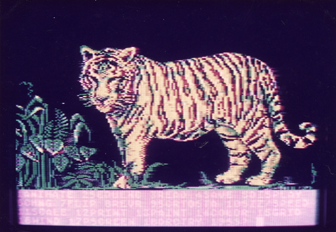
DP: I know Tod Frye did the 400/800 version (which was released), but I don't know who converted it for use on the 5200 (that version wasn't released).
Marilyn Churchill: Unfortunately I don't remember any more details about Asteroids. I also worked with Joe Tung on Galaxians (I recall helping Joe Tung with his Galaxian Easter eggs). I think Eric may have planted an Easter egg in Space Invaders. Howard Warshaw was famous for his.
DP: Did you do
any work with the coin-op department?
Marilyn Churchill:
Other than Dave Theurer's work on the animation program, the consumer division
did not work with coin-op.
DP: Do you have any other stories or anecdotes from those days that you can relate for us?
Marilyn Churchill: When I first began working at Atari I was impressed with the energy of the place. The programmers were really smart, creative, and excited about what they were doing and about their part in the future of technology.
I remember Howard Warshaw as a real comic. He always made me laugh with his off-the-wall jokes and quick wit. When he was working on Raiders of the Lost Ark, he had a bullwhip that he’d practice snapping in the hallways. And he wore a full-length black leather trench coat like something the character, Neo, wore in the movie, The Matrix.
For a while, Joe Tung slept in his van out in the parking lot. In the morning he would show up for work looking terribly wrinkled.
I remember many times talking philosophy with Tod Frye late into the night.
We had a dark, cavernous arcade room at Atari, filled with popular arcade games. Programmers spent many hours there working off frustrations and doing “research.”
Alan Murphy's dome house on Trout Gulch Road in Aptos was a very eccentric abode. IIRC he didn't buy that house until later, after he had worked at Atari for two years.
About a year and a half after I started working at Atari we experienced a sweet spot in time, (one of those “bubbles”) when gaming exploded in popularity and the demand for product outweighed the production. Our brash, young programmers were the only ones in the world who knew how to create the goods. This was when a royalty program was set up and some of the programmers began making huge amounts of money. With money pouring into Atari, we suddenly began to notice lots of “Suits” touring the halls. They seemed very alien in our casual environment of shorts and flip-flops. The gold rush period did not last long, but while it did—it was crazy. It was interesting to be at the center of that vortex.
DP: After Atari, you became a freelance computer graphics artist, working with companies such as Epyx and Sega. Do you recall what games you worked on, and what platforms they were for?
Marilyn Churchill: I freelanced with lots of companies on games and also on sales and educational presentations. I’m sorry to say that I’ve lost track of much of the work I did. Here are a few game titles I can recall:
Epyx "Baseball" - I don't think this was ever released. Jim Huether was the programmer. This was right around the time that Epyx went bankrupt. They ended up owing me $5000 which I was never able to collect.
Equilibrium Blasteroids - I remember that the graphics were very primitive, but I don't remember what system it was designed for.
Sega Jurassic Park - I was one of the artists contracted by Mimi (Dogett) Nyden to work on this for Sega. I did a series of 360 degree panoramas. I don't know if they were ever used in the final product. They decided to go 3D and a lot of things got changed. This was just before Sega offered me the job of Art Director of Graphics and Animation Support in a parallel department.
Tazmanian Devil - Alan Murphy sub-contracted my work on this. It consisted of a series of animations. He may have done other work on that same project.
I recall working on Mouse Tracks for Condon Brown, former Atari VIP, at his start-up company, The Software Machine. The project was designed for the first black and white Apple Macintosh and was being funded by Nolan Bushnell. But I don’t think the game was ever finished or released.
I began to specialize in educational software. I worked on Children’s Writing Center and Challenge of the Ancient Empires by The Learning Company for both the Mac and PC. I also free-lanced for Great Wave Software on Number Maze, Word Maze, Daisy Quest and others for Mac and PC.
DP: Can you describe your career, between your time at Atari and now, and what you’re currently involved with?
Marilyn Churchill: After free-lancing for several years, I worked for a year at Sega as Art Director for the Creative Support department. Then for three years I was Creative Director for Compaq computers where we partnered with Fisher-Price and designed 3-D educational software games for a toy console. I also worked for three years at Great Wave Software. Projects included: Prairie Explorer, Redwood Explorer, and Axel’s Whirled Math. In between corporate jobs I painted portraits and Renaissance-style angels, which became popular and were sold internationally as prints, posters and greeting cards.
Currently, I’m having a great time with my new company, Mystic Heroine Adventures, which I’m launching in November, 2008. I’ve written and illustrated two books in an ongoing adventure fantasy series. I’ve also designed a Mystic Heroine line of clothing. I’m writing a bi-weekly ezine called, “The Mystic Heroine Guide to Life, Love and Everything”: www.MysticHeroine.com.
DP: Do you still own any of your games for these systems, either as a keepsake, or to show friends or family?
Marilyn Churchill: I don’t have any of the old Atari games but I have some of my later software products.
DP: Have you stayed in touch with any of your former co-programmers?
Marilyn Churchill: Yes, a few. For years there was a group of us living in the Santa Cruz area and I used to party with them quite frequently. Once in a while there’s an Atari reunion and it’s always fun to catch up with old friends.
DP: What are your thoughts on how the video game industry has evolved – either in general or from a graphics artist’s standpoint?
Marilyn Churchill: Back in the day we used to dream of the amazing technology we have today. I’m not designing game graphics now, but I do all my illustration work on the computer. As a young artist I used to have a love/hate relationship with the computer. These days I prefer the computer over any other art medium.
DP: Do you (or did you) play video games – either for work or personal enjoyment?
Marilyn Churchill: I used to enjoy playing Pac-Man, Defender, Centipede, Space Invaders, Scramble, Missile Command, and Tempest, to name a few. I don’t play many games these days.
Below are some of Marilyn's "Matrix Animation" notes from 5200 Meebzork (click on each photo for a larger version):
For a copy of several versions of Dave Theurer's animation program that was used at Atari, click HERE.
| GAMEOLOGY |
| GAME | SYSTEM | COMPANY | STATUS |
| "submarine game" w/ Jim Huether | Atari VCS/2600 | Atari | not completed |
| Submarine Commander | Atari VCS/2600 | Atari | released |
| Galaxian | Atari 5200 | Atari | released |
| Space Invaders | Atari 5200 | Atari | released |
| Meebzork | Atari 5200 | Atari | not completed |
| Mouse Tracks | Mac | The Software Machine | unknown |
| Children's Writing Center | Mac, PC | The Learning Company | released |
| Challenge of the Ancient Empire | Mac, PC | The Learning Company | released |
| Number Maze | Mac, PC | Great Wave Software | released |
| Word Maze | Mac, PC | Great Wave Software | released |
| Daisy Quest | Mac, PC | Great Wave Software | released |
|
"Baseball" |
Epyx | ||
|
"Blasteroids" |
Equilibrium | ||
|
"Jurassic Park" |
Sega | ||
|
"Tazmanian Devil" |
Sega | ||
| Prairie Explorer | Great Wave Software | released | |
| Redwood Explorer | Great Wave Software | released | |
|
Axel’s Whirled Math |
Great Wave Software | released |